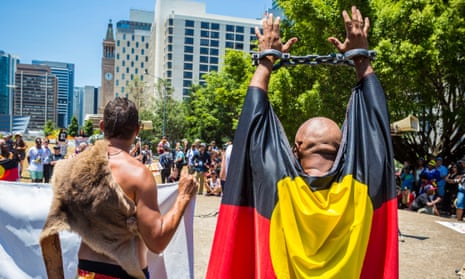The overrepresentation of Indigenous people in the justice system costs Australia $7.9bn a year and those costs are projected to increase to $19.8bn by 2040, according to economic modelling.
Reducing the rate of Indigenous imprisonment to be on par with non-Indigenous imprisonment would save $18.9bn by 2040, modelling produced by PriceWaterhouseCoopers showed, as well as reducing unquantified costs caused by policies that perpetuate the cycle of disadvantage.
Those unqualified costs included intergenerational trauma and continued high rates of child removal.
“The numbers are so huge that it amounts to a substantial budget repair measure,” PwC economics and policy partner James van Smeerdijk said.
The modelling, released on Thursday, is part of a report produced by PwC Indigenous Consulting, in partnership with the Change the Record Coalition, the Richmond Football Institute and the Korin Gamadji Institute.
It recommended national justice targets and greater investment in both diversionary and post-release programs as a way to reduce rates of imprisonment and deliver economic as well as social savings.
“The social impact of a reduction in imprisonment rates would be significant, changing lives and transforming communities,” the Change the Record coalition co-chair, Shane Duffy, said. “However this important collaborative report plays a key role in also highlighting the significant economic impact and potential savings for governments and in turn the taxpayer.”
In 2015-2016, Indigenous Australians made up 3% of the Australian population, 27% of the prison population and 51% of the juvenile detention population, a situation the report said was “unfair, unsafe and unaffordable”.
The Indigenous prison population has doubled in the 26 years since the royal commission into Aboriginal deaths in custody.
The cost of Indigenous incarceration in 2015-16 included $3.9bn spent on justice services, $62.5m spent on welfare such as out-of-home care for children whose parents were incarcerated, and $16.2m in foregone taxation, the report said.
It included a further $4.5m in broader costs such as the cost of crime, the loss of productive output and excess tax burden.
Projected future costs assumed Indigenous imprisonment would increase at a rate of 3%, assuming nothing was done to reduce current rates of overrepresentation, and an Indigenous population that was growing at 2.2% per annum. It did not contemplate the possibility of the rates of either new admission to prison or recidivism going up.
Van Smeerdijk said the conservative estimate made the figures even more persuasive. If there is not a systemic change in the justice system, the actual costs are likely to be much worse.
“I think if the average Australian actually realised some of these facts, realised how unfair, unsafe and unaffordable it was, that would be the start of changing peoples opinions,” he said.
Brendon Gale, chief executive of the Richmond Football Club, said the “unavoidable conclusion is that a different approach needs to be taken”.
“The good news is that, with combined action and effort, we can effect positive change in the domain of Indigenous incarceration,” he said.
Van Smeerdijk said he hoped the report would inform the findings of the Australian Law Reform Commission inquiry into Indigenous incarceration, which is due to release its preliminary report in June, and the final report of the Northern Territory royal commission into the protection and detention of children.
